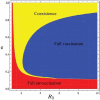Imperfect vaccine aggravates the long-standing dilemma of voluntary vaccination
- PMID: 21687680
- PMCID: PMC3110791
- DOI: 10.1371/journal.pone.0020577
Imperfect vaccine aggravates the long-standing dilemma of voluntary vaccination
Abstract
Achieving widespread population immunity by voluntary vaccination poses a major challenge for public health administration and practice. The situation is complicated even more by imperfect vaccines. How the vaccine efficacy affects individuals' vaccination behavior has yet to be fully answered. To address this issue, we combine a simple yet effective game theoretic model of vaccination behavior with an epidemiological process. Our analysis shows that, in a population of self-interested individuals, there exists an overshooting of vaccine uptake levels as the effectiveness of vaccination increases. Moreover, when the basic reproductive number, R0, exceeds a certain threshold, all individuals opt for vaccination for an intermediate region of vaccine efficacy. We further show that increasing effectiveness of vaccination always increases the number of effectively vaccinated individuals and therefore attenuates the epidemic strain. The results suggest that 'number is traded for efficiency': although increases in vaccination effectiveness lead to uptake drops due to free-riding effects, the impact of the epidemic can be better mitigated.
Conflict of interest statement
Figures

 , where
, where  . See main text for details.
. See main text for details.
 . Then the vaccine uptake level increases with the effectiveness. When the effectiveness exceeds a threshold,
. Then the vaccine uptake level increases with the effectiveness. When the effectiveness exceeds a threshold,  , however, the vaccination level decreases with the effectiveness. The lower panel shows the stationary abundance of the effectively vaccinated individuals with respect to the effectiveness. It is shown the efficient vaccinated individual increases with the effectiveness all the time. Thus the behavior of vaccination and the impact of the vaccination against epidemic are not in agreement: for high effectiveness, even though vaccination rate is decreasing, the number of effectively vaccinated individual increases as the effectiveness
, however, the vaccination level decreases with the effectiveness. The lower panel shows the stationary abundance of the effectively vaccinated individuals with respect to the effectiveness. It is shown the efficient vaccinated individual increases with the effectiveness all the time. Thus the behavior of vaccination and the impact of the vaccination against epidemic are not in agreement: for high effectiveness, even though vaccination rate is decreasing, the number of effectively vaccinated individual increases as the effectiveness  increases. Here
increases. Here  ,
,  satisfying
satisfying  .
.
 . The lower panel indicates the stationary abundance of the effectively vaccinated individuals with respect to the effectiveness. Compared with Fig. (2), the frequency of the effective vaccinated individual also increases with the effectiveness, but it is higher than that of Fig. (2). Here
. The lower panel indicates the stationary abundance of the effectively vaccinated individuals with respect to the effectiveness. Compared with Fig. (2), the frequency of the effective vaccinated individual also increases with the effectiveness, but it is higher than that of Fig. (2). Here  ,
,  satisfying
satisfying  .
.
 is the birth rate of the population. For the measles,
is the birth rate of the population. For the measles,  ,
,  and
and  ; For the flu
; For the flu  ,
,  and
and  , .
, .References
-
- Colgrave J. Berkeley, CA: University of California Press; 2006. State of immunity: the politics of vaccination in twentieth-century America.
-
- Fine P, Clarkson J. Individual versus public priorities in the determination of optimal vaccination polices. Am J Epidemiol. 1986;124:1012–1020. - PubMed
-
- Jansen VA, Stollenwerk N, Jensen HJ, Ramsay ME, Edmunds W, et al. Measles outbreaks in a population with declining vaccine uptake. Science. 2003;301:804. - PubMed
Publication types
MeSH terms
Substances
LinkOut - more resources
Full Text Sources
Medical

